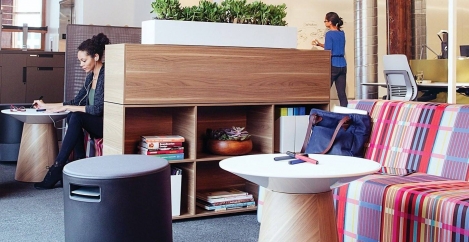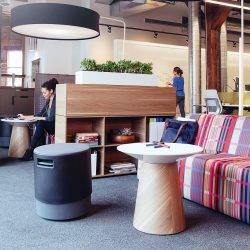November 27, 2023
From the archive: The role of workplace design in employee engagement 0
Originally published six years ago, this feature is currently the most read story ever on the website with around 50,000 readers. A global study by my own firm Steelcase has found that one-third of workers across 17 of the world’s most important economies are actually disengaged. The findings make worrying reading for employers around the world, as engagement is so demonstrably linked to business critical outcomes such as employee retention, productivity and even profits. It certainly raises the question of what more can be done, including in terms of workplace design, to boost engagement levels amongst these employees.
A great deal of current research and anecdotal evidence suggests that engaged employees are much less likely to leave their current organisation, are more productive and take less sick days that their disengaged colleagues. But according to a recent survey by Deloitte while 87 percent of organisations cite culture and engagement as one of their top challenges, almost two-thirds of executives do not feel they are effectively driving this desired culture within their business.
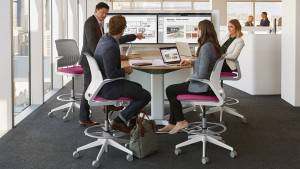 The study found that there is a strong correlation between high workplace satisfaction and high employee engagement, with employees who have greater control over their physical workplace – including access to private spaces – also reporting the highest engagement levels. The findings show that employers could be missing a trick when it comes to planning their employee engagement strategies.
The study found that there is a strong correlation between high workplace satisfaction and high employee engagement, with employees who have greater control over their physical workplace – including access to private spaces – also reporting the highest engagement levels. The findings show that employers could be missing a trick when it comes to planning their employee engagement strategies.
This is because, consistently, the most engaged workers were those who had more control over their work experience, including the ability to concentrate easily and work in teams without being interrupted. Workers who have the ability to choose where they want to work in the office based on the task at hand are much more engaged in the work they do.
Key findings from the global workplace design report include:
Employee engagement positively correlates with workplace satisfaction. The data shows that workers who are highly satisfied with various aspects of their workplace also demonstrate higher levels of engagement. Yet, only 13 percent of global workers are highly engaged and highly satisfied with their workplace. The inverse is true as well: 11 percent of employees are highly dissatisfied with their offices and are also highly disengaged.
[perfectpullquote align=”right” bordertop=”false” cite=”” link=”” color=”” class=”” size=””]A distinguishing characteristic of engaged employees is that they have a greater degree of control over where and how they work[/perfectpullquote]
Engaged employees have more control over their experiences at work. A distinguishing characteristic of engaged employees is that they have a greater degree of control over where and how they work, including access to privacy when they need it. They are empowered, both by organisational decisions and the spaces made available to them within their workplace, to make choices about where and how they work. This means they can manage their need for privacy, concentrate more easily and collaborate with their teams without disruptions.
Fixed Technology exceeds mobile by 2:1. Despite the high global adoption of mobile devices for personal use, the vast majority of respondents report that their organisations provide twice as much fixed technology as mobile options for work. The vast majority of workers report that they are equipped with landline telephones (86 percent) and desktop computers (80 percent). Far fewer employees have laptops (39 percent), mobile phones (40 percent) or tablet computers (13 percent) available to them at work. And in recent UK research, 16 percent said that the technology they used at home was far superior to that provided by their employer[vi].
Traditional work styles persist. Across the globe, the most common workplace layout features a combination of open spaces and private offices, but more than 60 percent of global employees say they work in either individual or shared private offices. The greatest contrast in open environments and private or shared offices can be seen in Europe, where in the United Kingdom nearly half of all office layouts are entirely open (49 percent), while in Germany 54 percent of overall physical workplaces consist entirely of individual or shared private offices.
Cultural context influences engagement levels. The most highly engaged employees hail from emerging economies, where people have different expectations of their work environments than those in established economies. Workers from developing countries such as India and Mexico are some of the most highly satisfied and engaged, while people in France, Belgium and Spain are less engaged. Analysis of the data identified a pattern indicating that the country where employees live, its culture and the resulting expectations have an impact on how highly engaged and satisfied they are with their workplace.
For organisations on the path towards global integration, it’s important to challenge assumptions and look broadly at the diverse factors that influence employee engagement. Well-designed workplaces can communicate a company’s strategy, brand and culture, while encouraging the behaviours leaders want to see in their organisation – all fostering higher engagement levels.
How workplace design can be used to boost employee engagement
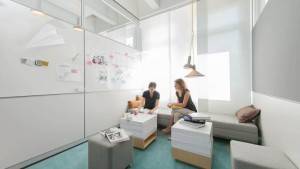 Organisations looking to improve employee engagement might be surprised to learn nearly one-third of workers are neither engaged nor disengaged but fall somewhere in the moderate middle. These workers might not be actively hurting an organisation, but they are not benefitting it, either. As they make up such a large portion of the workforce, just a small improvement in their engagement levels could have a significant impact on business performance. One way of doing this is to make some important changes to their work environment.
Organisations looking to improve employee engagement might be surprised to learn nearly one-third of workers are neither engaged nor disengaged but fall somewhere in the moderate middle. These workers might not be actively hurting an organisation, but they are not benefitting it, either. As they make up such a large portion of the workforce, just a small improvement in their engagement levels could have a significant impact on business performance. One way of doing this is to make some important changes to their work environment.
By maximising the potential of workplace design there are things you can do to help boost employee engagement. This means designing in what you could describe as “a resilient workplace”: one that is most likely to have a positive impact on employee engagement levels. This approach can be modified and interpreted to suit the culture of each organisation and the country it operates in. No two companies are the same. But the principles are universal. Here are seven ways in which you can address the engagement gap.
Create a workplace design that offers people choice and control over when and how to work.
The global report highlights how employees, who have more control over various aspects of their workplace and work experience, are more engaged. Therefore, empowering people to decide where and how through workplace design they will be most productive is one strategy organisations can employ.
No two days are the same for employees; sometimes they will need to do focus work, while other times they will need to collaborate. Sometimes they will prefer to be alone in a quiet space, and other times they will prefer to be in a café with people and a buzz around them. It is important to be able to choose what works best on any given day.
[perfectpullquote align=”right” bordertop=”false” cite=”” link=”” color=”” class=”” size=””]empowering people to decide where and how through workplace design they will be most productive is one strategy organisations can employ[/perfectpullquote]
Technology is a critical factor in giving employees more choice and control over where and how they work – yet many organisations appear to be lagging behind with fears over data security and a perceived lack of cooperation and cohesion among employees who would no longer be working side by side. The Steelcase study highlights how many employees are still working in a traditional way, with a fixed PC and telephone, thereby restricting them to working at their desks. To avoid this, the IT strategy needs to be aligned with their workplace goals to succeed in building a more engaged culture.
Enhance and promote collaboration through workplace design, particularly for teams based across different locations
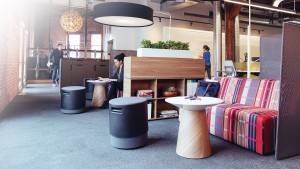 Collaboration is key to any workplace, but the space should be designed to support a wide variety of collaboration styles as well. For example, a project room for intense activity amongst three to six people could feature a high seating position to support movement and active brain activity, with whiteboards and technology to share digital content. That will differ quite dramatically from what you need for a training session, interacting with a client or supplier, or for a videoconference with a colleague based on the other side of the globe.
Collaboration is key to any workplace, but the space should be designed to support a wide variety of collaboration styles as well. For example, a project room for intense activity amongst three to six people could feature a high seating position to support movement and active brain activity, with whiteboards and technology to share digital content. That will differ quite dramatically from what you need for a training session, interacting with a client or supplier, or for a videoconference with a colleague based on the other side of the globe.
Space should support those different interactions through varied working environments, allowing employees to share ideas and co-create, work in teams without being interrupted and enable a culture of creativity and innovation – whether this happens with a team physically in the room, or virtually with colleagues spread across continents and time zones.
Provide employees with areas where they can focus, concentrate and have some privacy
The study shows that highly engaged workers have more access to spaces where they can concentrate than their disengaged counterparts. Furthermore, neuroscience teaches us that our brain is not designed for multitasking and that staying focused requires energy – by definition a limited resource.
[perfectpullquote align=”right” bordertop=”false” cite=”” link=”” color=”” class=”” size=””]It can be very stressful for employees if they have nowhere to take a personal call during the day or simply “be alone”[/perfectpullquote]
According to the University of California, we are open to distraction every three minutes, with a consequent impact on our ability to focus and concentrate. To avoid this, employees should be provided with a variety of spaces that allow concentration and personal focus. Experts agree that creating an office that is tailored to employee needs, and which provides a menu of settings is always the best solution.
This is particularly important for employees in open plan offices, to allow them to balance constant contact with colleagues with moments of privacy and disconnection. It can be very stressful for employees if they have nowhere to take a personal call during the day or simply “be alone”. Open plan offices must therefore be balanced with spaces for personal rejuvenation where staff can read a magazine, change posture and disconnect. Having the chance to switch off when they need to will enable staff to perform better over a longer period.
Provide spaces for social, informal connections.
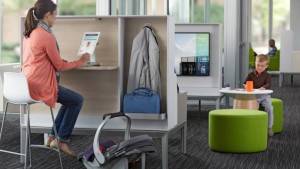 We are social animals. We need spaces where we can connect informally with our colleagues and have the opportunity to discuss work in a more relaxed, informal and pleasant setting. Space shapes behaviour and often the traditional meeting room with formal seats around a large table is not the ideal setting for an effective conversation. It is therefore important to provide spaces for social, informal connections throughout the day, whether these are planned or more impromptu.
We are social animals. We need spaces where we can connect informally with our colleagues and have the opportunity to discuss work in a more relaxed, informal and pleasant setting. Space shapes behaviour and often the traditional meeting room with formal seats around a large table is not the ideal setting for an effective conversation. It is therefore important to provide spaces for social, informal connections throughout the day, whether these are planned or more impromptu.
When designed effectively, these social spaces should bring to the office the same vibe and emotional comfort of a café while also offering the support required for work, through connection to technology, support of a proper physical posture and also the ability to manage visual privacy when required.
One of the concepts that Steelcase promotes is the Workcafe: the transformation of the traditional cafeteria or corporate restaurant into an informal, but harder working space that offers a diversity of zones not just for social connections. Open all day, it provides an environment where people can gather when they choose over coffee or lunch, but also work individually or organise meetings.
Enable workers to physically move around during the day and change postures.
Engaged employees are healthy employees. It is therefore essential for staff to keep moving throughout the day to maintain their physical wellbeing. Space should support a diversity of postures and encourage movement – whether through sit-stand desks, seating designed to support interaction with mobile devices, even lounge seats that allow staff to sit back with their feet up to relax. There are numerous options to boost physical wellbeing. Movement is a key enabler for brain regeneration, thereby helping us to generate our best ideas.
Make your brand and company culture visible and give employees permission to be themselves
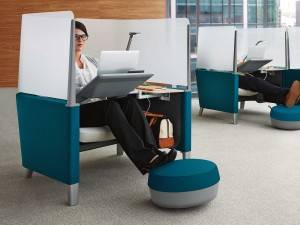 Employee engagement is possible only when there is a culture of trust, where employees feel they belong to the community and are free to express their ideas. Space plays a key role in driving company values, in giving signals about business priorities, as well as showing what behaviours are accepted and encouraged. It can also give an indication about factors such as how accessible leadership is.
Employee engagement is possible only when there is a culture of trust, where employees feel they belong to the community and are free to express their ideas. Space plays a key role in driving company values, in giving signals about business priorities, as well as showing what behaviours are accepted and encouraged. It can also give an indication about factors such as how accessible leadership is.
Once again there is not “one size fit all” solution, as space is always influenced by where the company is located – Japan and South America are not the same – in which sector it operates – banking or software for example – and of course, what the company culture is and what they want to promote – whether it’s innovation or tradition, attracting young talent or preserving well-established knowledge. All these factors need to be considered so that the physical workspace represents and encourages the desired behaviours.
It is also crucial to consider the importance of designing leadership team spaces. Contrary to tradition, the company CEO or Managing Director is no longer always the employee with the largest office, a huge desk and a secretary outside. Instead, leaders today seek transparency, a connection with their teams and to lead by example. For instance, with its ‘Better Ways of Working’ initiative, at Vodafone, no-one, not even the leadership team or the chief executive, has their own office. People work in ‘home zones’ and are free to take their laptop to any one of a number of work spaces, or to one of the coffee shops.
In terms of spaces, as with other employees leaders need access to a balance of private and team working areas plus social and community spaces. Company leadership spaces often reveal a lot about how a company wants to be perceived by its own employees, what its values are and the behaviours that it encourages or discourages. These areas should be carefully designed with this in mind.
Create a workplace design that accommodates visitors, mobile workers and guests
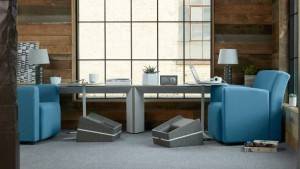 Workspaces should not be designed for employees only. With more and more workers coming from different locations to use the office as a “hub”, workspaces are becoming areas of interaction between a variety of colleagues, contractors and freelances, as well as representing the company towards external guests.
Workspaces should not be designed for employees only. With more and more workers coming from different locations to use the office as a “hub”, workspaces are becoming areas of interaction between a variety of colleagues, contractors and freelances, as well as representing the company towards external guests.
It is therefore important that spaces consider these populations and facilitate their mobility through the space according to who they are and where/how they want to work. Employers must aim to create resilient workplaces, which encourage people and organisations to be more agile, engaged and which can evolve other time as needed.
As a conclusion….
Engagement is a complex topic, with many variables to consider. Redesigning the workplace is just one of many factors that can have an impact. However, the new Steelcase report shows that in many organisations workplace design is overlooked, when it can have a significant impact on employee engagement and satisfaction.
The physical surroundings can shape employee behaviours, feelings and attitudes towards their employer and experiences at work. To maximise its performance, organisations must think about the workplace as an ecosystem of spaces that allow people to have choice and control over where and how they work. Only then will they feel fully supported and able to perform at their best.
This feature was originally published in Work&Place
________________________________
Serena Borghero was born in Milano, Italy, where she studied Business Administration at the Bocconi University in Milano and at the UCL in Brussels. She joined Steelcase in 2000, covering different roles both within the corporate and the regional offices. In 2012 Serena joined the new born Coalesse team within Steelcase, being responsible for Marketing, Communications and Public Relations in EMEA. Today, she is Director Media Communications of both Steelcase and Coalesse in EMEA.
References
- www.kpmg.com/US/en/IssuesAndInsights/ArticlesPublications/Documents/real-value-of-engaged-employees.pdf
- www2.deloitte.com/uk/en/pages/human-capital/articles/introduction-human-capital-trends.html
- Engagement and the Global Workplace: https://info.steelcase.com/global-employee-engagement-workplace-report#introduction
- Harvard Business Review – https://hbr.org/2013/07/employee-engagement-does-more/
- The Steelcase report, Engagement and the Global Workplace, was compiled with data collected by global research firm Ipsos from 12,480 workers in 17 countries. It set out to understand if the physical workplace could be used as a strategic asset to help improve employee engagement and what changes could make the largest impact.
- https://workplaceinsight.net/21761-2/
- www.unwork.com/wp/2013/03/28/making-mobile-working-a-reality/
- Work &Place May 2015: Managing the intersecting worlds of work on a global scale, Paul Statham
- The Cost of Interrupted Work: More Speed and Stress: www.ics.uci.edu/~gmark/chi08-mark.pdf
- https://workplaceinsight.net/everything-you-want-to-know-about-open-plan-but-are-too-distracted-to-ask/#more-16520
- https://workplaceinsight.net/the-low-down-on-sit-stand-workstations/





